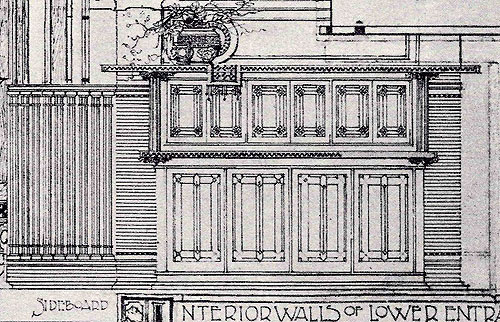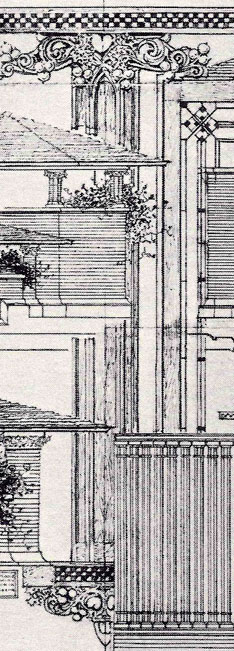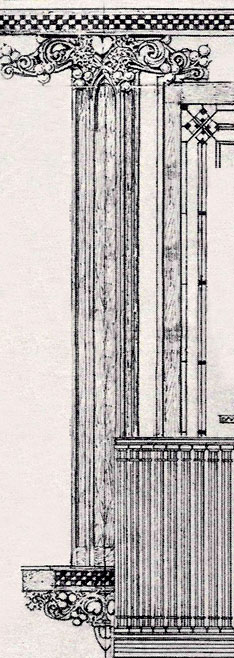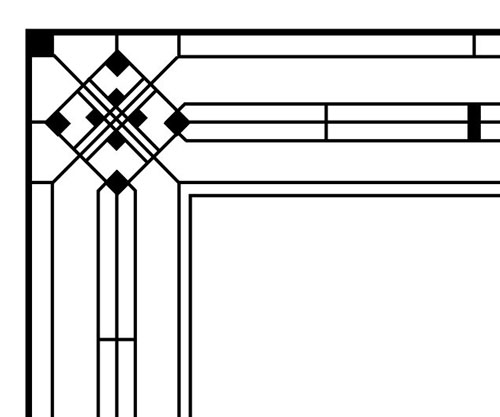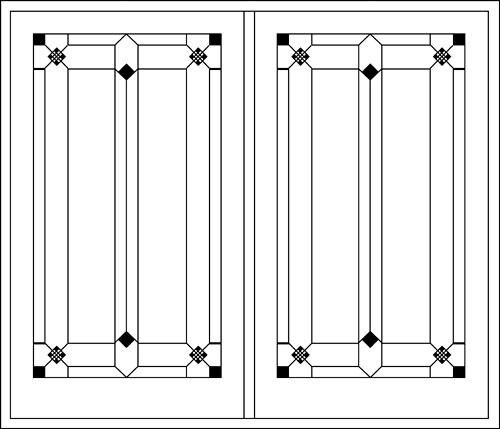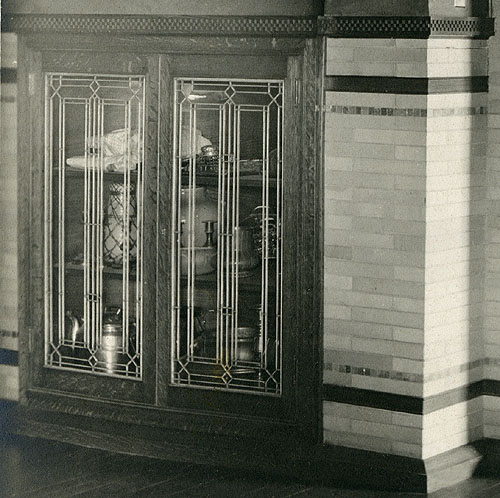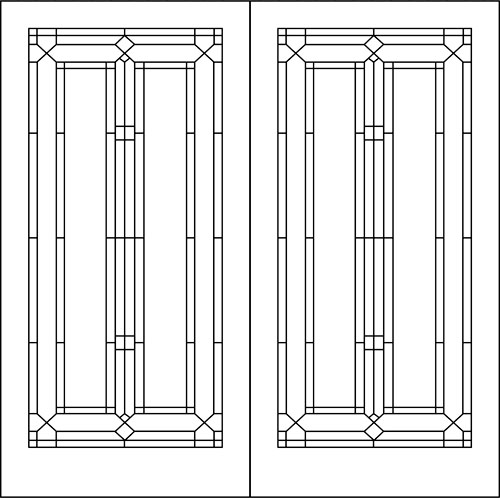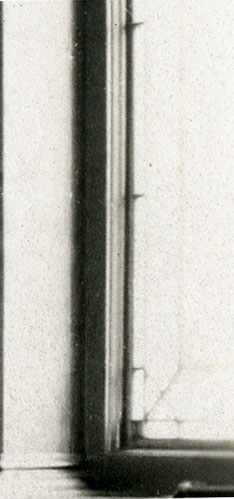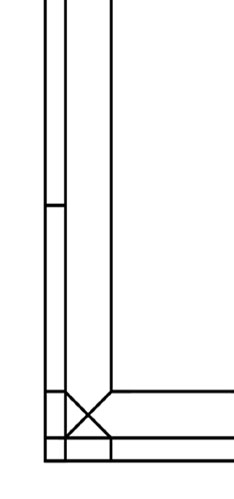|
|
|
Joseph and
Helen Husser Residence, Chicago (1899 - S.046) |
|
|
|
|
Wright incorporated the glass
mosaic designed fireplace in three of his homes. The
first was the Husser Residence (1899), and was destroyed in
1924. The second and much more extensive fireplace was the
Darwin Martin Residence (1904) was left to deteriorate when
the home was vacant between from 1935 to 1950. Only
photographic records and a few glass pieces remain. The
final home was the Ennis Residence (1924). Although other
examples exist, this is the only Wright glass mosaic
fireplace that survived. The wisteria design was consistent
in all three homes, and was designed by Blanche Ostertag and
executed by Orlando Giannini.
Wright previously utilized Orlando
Giannini's talents, commissioning him to paint three murals
in his own Oak Park home in
1895, "Genie
& The Fisherman Mural", and two American Indian Murals. He also painted a
mural in the Williams
home.
Husser
Residence Fireplace. "A very recent innovation not yet in
place is the facing of gold enamel and glass mosaic for one
of the Husser fireplaces. Quietly framed within broad bands
of Caen stone, the combination of gold in fusion with color on
porcelain have been made to delineate vine trunks and
a weeping profusion of wisteria sprays and pendent blossoms
upon a ground dull gold below and bright gold above a
suggested horizon. The white joints have been employed with
|
|
great
skill to delineate dainty stems and leaves of softer green and
crackled gold. The sprays of blossoms are inlays of rosy
white and pearly glass which fall in the airiest, sweetest
fashion from the tangle of leaves above. Mr. Wright as
architect, Miss Ostertag as artist, and Mr. Giannini
as craftsman and burner of remarkable enamels, have
co-operated to show what may be conceived and executed here above and
beyond precedent. They have more than succeeded. No
monochrome can even suggest the exquisite beauty of this
facing in its splendent play of iridescent color, of which
the public has fortunately had a view at the recent
exhibition of the Architectural Club." Published in "The Architectural Review",
June 1900.
The illustration's text reads, "Fire Place
In Husser House. Golden Mosaic _ _e Front Set In Caen Stone
and Let_ _ Flush With Brick Work."
Of interest is the
Copper Urn
and Candlestick. Wright included
them in a number of drawings and
projects he worked on. The Urn was
included in the
Edward C. Waller house, Wright's own
Home and Studio, the
Dana
house, the
Coonley house,
Browne's Bookstore and appeared in
an early image of
Unity Temple.
The fireplace screen is similar to the
screen in the in the Darwin Martin residence. |
|
|
|
|
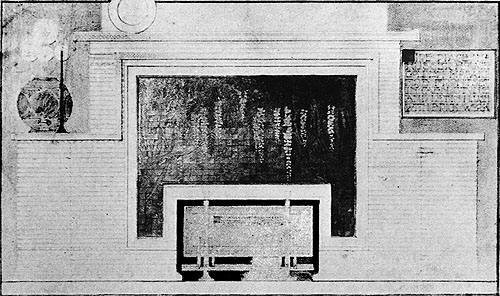 |
| 1) "The
face above the fireplace is made gold enamel and glass mosaic for the
Living Room fireplaces. Quietly framed within broad bands of
Caen stone, the combination of gold in fusion with color on
porcelain have been made to delineate vine trunks and
a weeping profusion of wisteria sprays and pendent blossoms
upon a ground dull gold below and bright gold above a
suggested horizon. The white joints have been employed with
great skill to delineate dainty stems and leaves of softer
green and crackled gold. The sprays of blossoms are inlays
of rosy white and pearly glass which fall in the airiest,
sweetest fashion from the tangle of leaves above." Published in "The Architectural Review",
June 1900. The illustration's text reads, "Fire Place
In Husser House. Golden Mosaic _ _e Front Set In Caen Stone
and Let_ _ Flush With Brick Work." |
| |
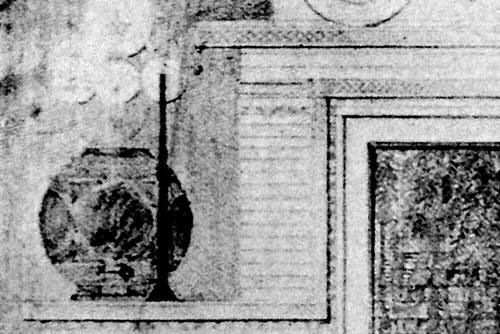 |
| 2) The
checkerboard pattern, in evidence here in the Living Room
Fireplace mantel, was repeated throughout the home. Of
interest is the
Copper Urn
and Candlestick. Wright included
them in a number of drawings and
projects he worked on. The Urn was
included in the
Edward C. Waller house, Wright's own
Home and Studio, the
Dana
house, the
Coonley house,
Browne's Bookstore and appeared in
an early image of
Unity Temple. |
| |
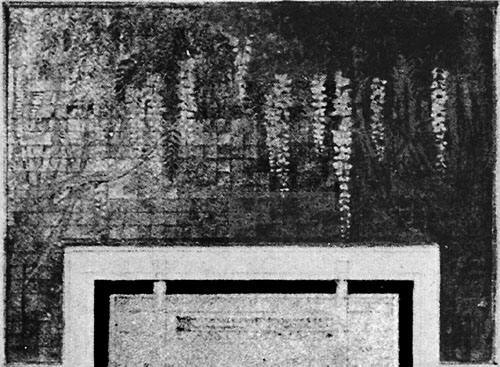 |
| 3) "The
face above the fireplace is made gold enamel and glass mosaic for the
Living Room fireplaces. Quietly framed within broad bands of
Caen stone, the combination of gold in fusion with color on
porcelain have been made to delineate vine trunks and
a weeping profusion of wisteria sprays and pendent blossoms
upon a ground dull gold below and bright gold above a
suggested horizon. The white joints have been employed with
great skill to delineate dainty stems and leaves of softer
green and crackled gold. The sprays of blossoms are inlays
of rosy white and pearly glass which fall in the airiest,
sweetest fashion from the tangle of leaves above." Published in "The Architectural Review",
June 1900. |
| |
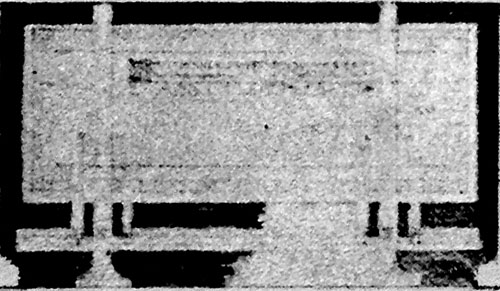 |
| 4) The
Husser Living Room Fireplace screen is similar to the screen
in the Darwin Martin residence. |
| |
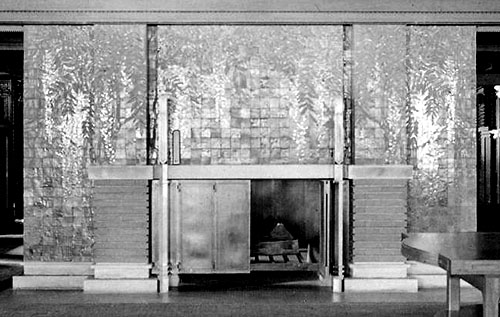 |
| 5)
Darwin Martin Fireplace (S.100-102 - 1904). Five years
after the Husser Home, Wright designed the Martin Residence.
Wright replicated the Husser Fireplace, but on a grander
scale. The left and right sides are mirrored images, and
wrap around the left and right sides. Photographed in 1908 by
Henry Fruemann. |
| |
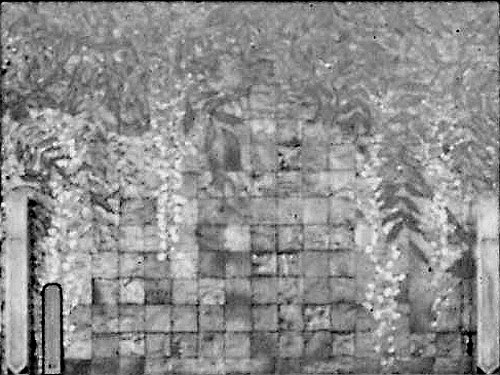 |
| 6) Detail
of the Martin fireplace.
Section directly above the fireplace. |
| |
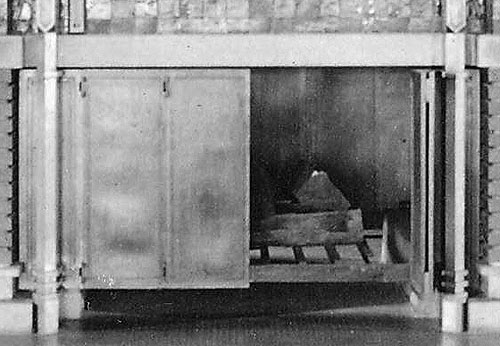 |
| 7) The
Darwin Martin fireplace screen is similar in concept to the
design in the
Husser Living Room Fireplace illustration. |
| |
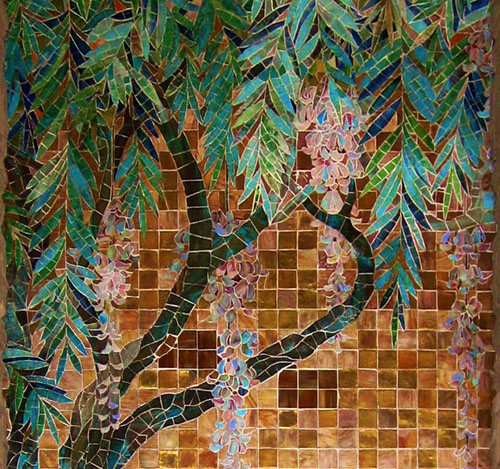 |
| 8)
Fireplace in the Ennis Residence (1924). Although other
examples exist, this is the only Wright glass mosaic
fireplace to survive and an excellent example of the Husser
and Martin Residences. |
| |
| |
| |
|
|
Husser Living Room
Fireplace Discovered (Husser, Martin) |
|
|
|
|
It all began
with an e-mail from Ted Ellison. "...I came across
an image in The Early Work of Frank Lloyd Wright that shows
a detail of the Martin mosaic - however that didn’t seem
right to me and through image comparisons I realized that
it’s the Husser mosaic."
Well, we believe
he is right. We decided to compare the Husser fireplace to
the Martin fireplace, and the following is what we found. We
followed the timeline.
Figure 1, published in 1900, clearly established the Husser
fireplace,
"Mr. Wright as
architect, Miss Ostertag as artist, and Mr. Giannini as
craftsman and burner of remarkable enamels..." Frank Lloyd
Wright chooses to create a collage to portray the fireplace,
a photograph and a drawing, possibly due to timing. The
mosaic may have been completed, as seen in Figure 3, before
the fireplace itself was completed.
Figure 2 is nearly the same drawing of the Husser fireplace
as Figure 1, but
misidentified as
the Martin fireplace. It is clearly the Husser fireplace,
not the Martin fireplace.
Figure 3 is clearly identified as the Husser "overmantel" by
Manson, and was photographed before it was installed, which
sheds light on the collage in Figure 1.
Figure 4 was published in the June 1900 issue of
Art-Interchange. It clearly established that "Frank
Lloyd Wright, architect, is responsible for the creation of
the innovation,
and Orlando Giannnini invented the new glass work... The
motive
use by Miss Ostertag
is based on the study of the wisteria |
|
vine in blossom."
Although the
article does not mention the Husser Residence by name, the
Martin Residence was not conceived until 1904.
Figure 5 is where the confusion began. Published
in Frank Lloyd Wright Ausgefuhrte Bauten, and Frank Lloyd
Wright Chicago, Wright, they are both identified as the
Martin fireplace. But after close examination and overlaying
Figure 5 over 3 (Fig. 5A-B) and 4
(Fig. 5C-D), it becomes clear that it is a
photograph of the Husser fireplace mantel not the Martin
mantle.
Figure 6,
the Darwin D. Martin Residence Fireplace Study, an
illustration published in The Prairie School Tradition. The
study is very similar in design to the Husser fireplace.
Figure 7A-C, the Darwin D. Martin Residence Fireplace was
first published in the March 1908 issue of Architectural
Record, and was photographed shortly after completion.
Figure 8, drawn in 1987, is the Darwin D. Martin Residence
Mosaic Fireplace
left side and left front panel. The
illustration is helpful in simplifying the design visually.
Figure 9A-B.
Photographed in 2017 after the extensive
restoration of the Darwin Martin House.
There is no conclusive answer as to why the photograph,
Figure 5, was misidentified as the Husser fireplace. Was it
miss filed? A misunderstanding on the part of the printer?
We can only speculate. We may never know, but we can
say with confidence that it is the Husser overmantle, not
the Martin. |
|
|
F1 |
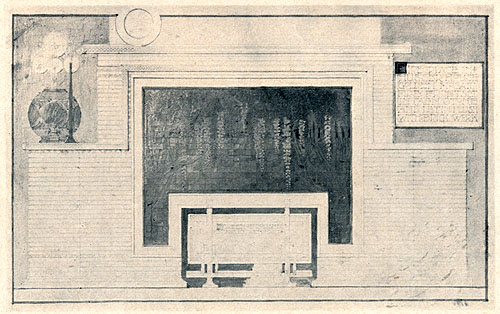 |
|
Figure 1:
Joseph & Helen Husser Residence Fireplace Drawing 1900 (1899 -
S.046).
This drawing was published
in the June 1900, Architectural Review. During the final stages
of the completion of the Husser Residence, Robert C. Spencer,
Jr. describes the home in the June 1900 issue of
The Architectural
Review. "A very recent innovation not yet in place is the
facing of gold enamel and glass mosaic for one of the Husser
fireplaces. Quietly framed within broad bands of Caen stone, the
combination of gold in fusion with color on porcelain have been
made to delineate vine trunks and a weeping profusion of
wisteria sprays and pendent blossoms upon a ground dull gold
below and bright gold above a suggested horizon. The white
joints have been employed with great skill to delineate dainty
stems and leaves of softer green and crackled gold. The sprays
of blossoms are inlays of rosy white and pearly glass which fall
in the airiest, sweetest fashion from the tangle of leaves
above. Mr. Wright as architect, Miss Ostertag as artist, and Mr.
Giannini as craftsman and burner of remarkable enamels, have
co-operated to show what may be conceived and executed here
above and beyond precedent. They have more than succeeded. No
monochrome can even suggest the exquisite beauty of this facing
in its splendent play of iridescent color, of which the public
has fortunately had a view at the recent exhibition of the
Architectural Club. This bit of mosaic is for the Husser home,
whose interior walls are of a dull yellow brick engaged with
deep toned and unvarnished wood with inlaid lines of tawny gold
mosaic that mark the beginning of a new epoch in the use of
permanent and beautiful materials for domestic interiors in the
west." A photograph of the mosaic is added to the illustration.
The checkerboard pattern, in evidence here in the Living Room
Fireplace mantel, was repeated throughout the home. Of interest
is the Copper Urn and Candlestick. Wright included them in a
number of drawings and projects he worked on. Text top right:
"Fire Place In Husser House. Golden Mosaic Fire Front, Set In
Caen Stone and Let In Flush With Brick Work."
(S#0041.,22.1018) |
| F2 |
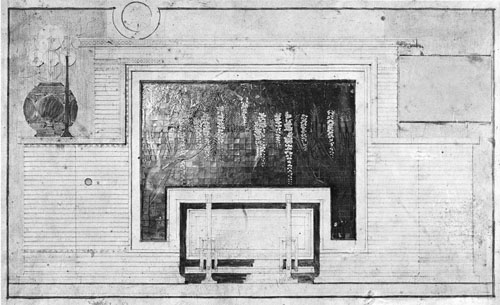 |
|
Figure 2: Joseph & Helen Husser
Residence Fireplace Drawing 1900 (1899 - S.046). This
drawing, plate 188, was published in
Frank
Lloyd Wright Monograph 1902-1906, Volume 2, Pfeiffer,
1987, p.109, plate 188. Published as part of the Martin
residence, not identified as the Husser fireplace, but
misidentified as the Martin fireplace. Plate 186 is
correctly identified as the plan for the Martin fireplace.
Hand written on plan 186: "Gold Mosaic Wisteria," "Wisteria
Fireplace" and "Mosaic Fire Place, D. D. Martin, Buffalo."
The only difference between this illustration and the Husser
1900 Architectural Review is that this illustration is
missing the square and text in the upper right hand block,
and also the text in the fireplace screen which is too faded
out to read. (S#: 0041.27.1118) |
| F3 |
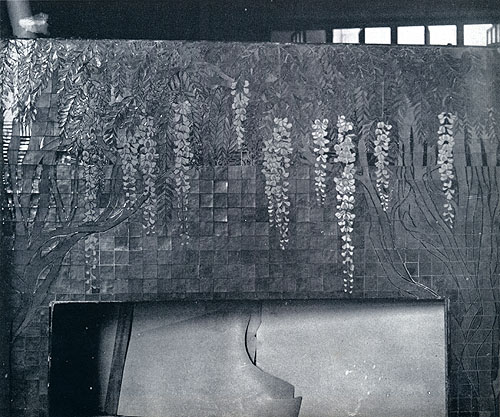 |
|
Figure 3: Joseph & Helen Husser Residence Fireplace Circa 1899-1900 (1899
- S.046).
This photograph was published
in Frank Lloyd Wright To
1910, Manson, 1958, p.148. Appears to be completed, but not
installed around the fireplace. (S#0041.23.1018) |
| F4 |
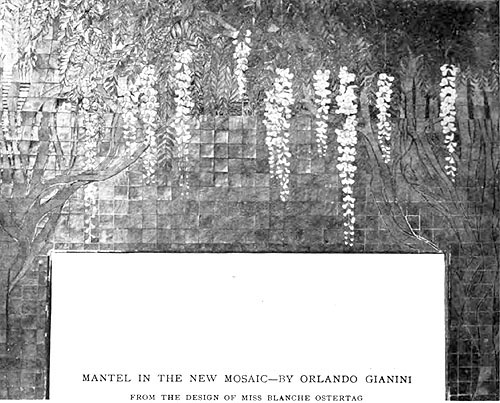 |
|
Figure 4: Joseph & Helen Husser Residence Fireplace 1900 (1899 - S.046).
This photograph was published
in the June 1900, The Art-Interchange,
P.130. "Two fireplaces in mosaic have attractive much attention
in Chicago. One is in true mosaic such as the centuries have
known: the other is different, and called "mosaic" simply for
convenience. It is a new invention, or a new application --
which amounts to the same thing... Frank Lloyd Wright,
architect, is responsible for the creation of the innovation,
and Orlando Giannnini invented the new glass work... The motive
use by Miss Ostertag is based on the study of the wisteria vine
in blossom. The thick trunks of the vine climb up either jamb
and, branching, lose themselves in a mass of well-drawn foliage
above a conventionalized wall. The bunches of flowers are not
formally arranged, but seem to grow as the accidents of nature
allowed..." James William Pattison. Although the article does
not mention the Husser Residence by name, the Martin Residence
was not designed until 1904. (S#0041.24.1018) |
|
F5 |
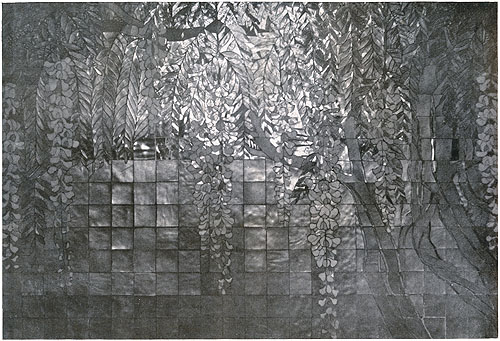 |
Husser Fireplace Discovered.
Figure 5: Joseph & Helen Husser
Residence Fireplace Circa 1900 (1899 - S.046).
This photograph was published in the Frank
Lloyd Wright Ausgefuhrte Bauten, Wright, 1911, p.110, and in
Frank Lloyd Wright
Chicago, Wright, 1911, p.44. Both are identified as the
Martin
fireplace. AB: "Wohnhaus Martin, Buffalo, N. Y. Kaminwand in Gold-Glasmosaik"
translates "Martin House, Buffalo, N. Y. Fireplace Wall in Gold and Glass
Mosaic." Chicago: "Wohnhaus Martin, Buffalo, N. Y. Mantelverkleidung in
Glasmosaik" translates "Martin House, Buffalo, N. Y. Mantel Paneling in
Glass Mosaic." Thanks for the heads-up from Tim Ellison. Although identified
as the fireplace mosaic from the Martin Residence (1904), it is actually the
fireplace mosaic from the Husser Residence, demolished in 1924. In 1968,
The Early Work By
Frank Lloyd Wright, Wright, p.110, it was miss identified again as
the Martin Fireplace.
(S#0041.26.1018) |
| F5A |
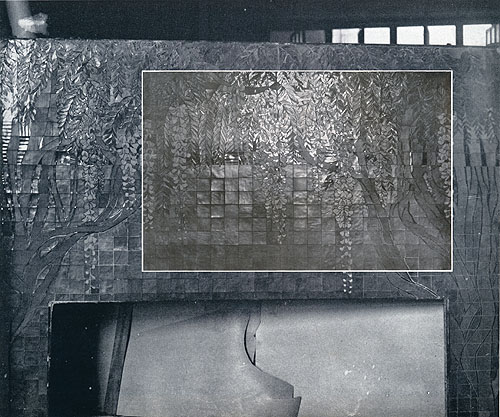 |
| Figure 5A. Figure 5 is
superimposed over Figure 3. |
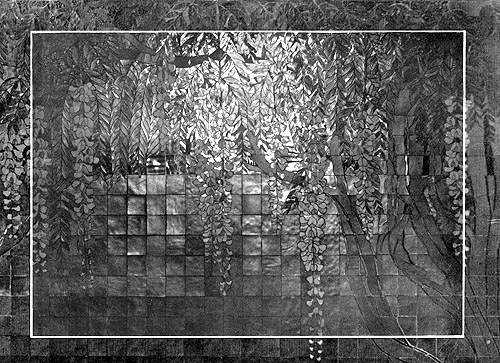 |
| Figure 5B: Figure 5 is
superimposed over Figure 3 and cropped. |
| F5C |
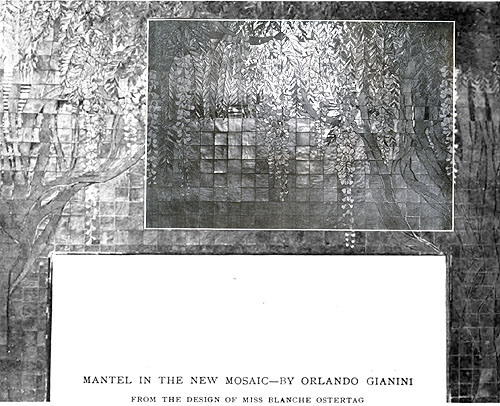 |
| Figure 5C. Figure 5 is
superimposed over Figure 4. |
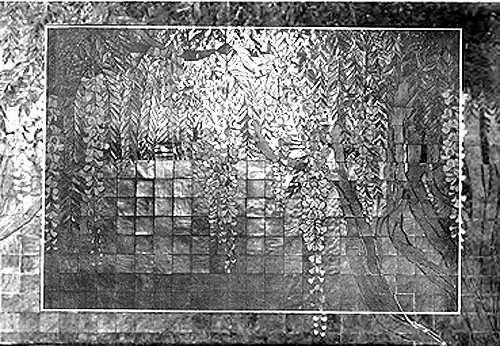 |
| Figure 5D: Figure 5 is
superimposed over Figure 4 and cropped. |
| F6 |
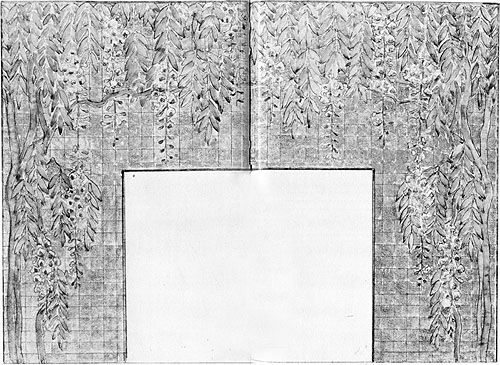 |
|
Figure 6:
Darwin D. Martin Residence Fireplace Study 1904 (S.100 - 1904).
This illustration
was published in The Prairie
School Tradition, Spencer, 1979, p.58-59. Caption: "Darwin
D. Martin Residence, Buffalo, New York. 1904. Fireplace study,
pencil and watercolor on tracing paper. Delineated by George M.
Niedecken." (S#:
0055.15.1018) |
| F7 |
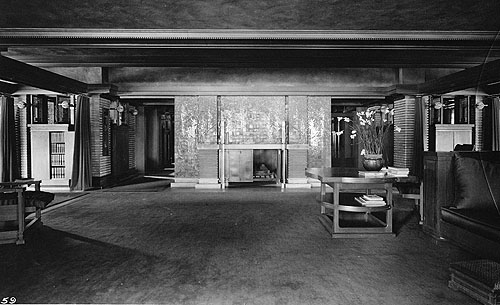 |
|
Figure 7A: Darwin D. Martin Residence Fireplace
Circa 1908 (S.100 - 1904). Frank Lloyd Wright designed the Martin
Residence in 1904. This photograph was first published in the
March 1908 issue of
Architectural Record. Of the
Husser fireplace mosaic, Spencer wrote, "Mr. Wright as architect, Miss Ostertag as artist, and Mr. Giannini as craftsman and burner of remarkable
enamels, have cooperated to show what may be conceived and executed here
above and beyond precedent."
Architectural Review, June 1900, Robert C.
Spencer, Jr. At the same time, Pattison wrote of the same fireplace, "Frank
Lloyd Wright, architect, is responsible for the creation of the innovation,
and Orlando Giannnini invented the new glass work... The motive use by Miss
Ostertag is based on the study of the wisteria vine in blossom." The
Art-Interchange, June 1900, James William Pattison. The three collaborated
again on the Martin Fireplace. For more information on the work of Blanche Ostertag,
see
Frank Lloyd
Wright Newsletter, 2nd Quarter, 1981, p.11-16. This
photograph published in the
Frank Lloyd
Wright Ausgefuhrte Bauten,
Wright, 1911, p.50, and in
Frank Lloyd
Wright Chicago,
Wright, 1911, p.35. Also published in
Frank Lloyd Wright’s
Martin House, Quinian, 2004,
p.116. Photographed by Henry Fuermann. The Martin fireplace is
very similar to the
Husser Fireplace.
(S#0085.41.1018 A) |
| |
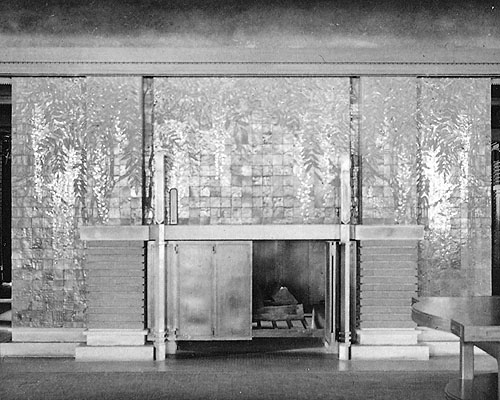 |
|
Figure 7B: Detail of Darwin D. Martin
Residence Fireplace Circa 1908. (S#0085.41.1018
B) |
| |
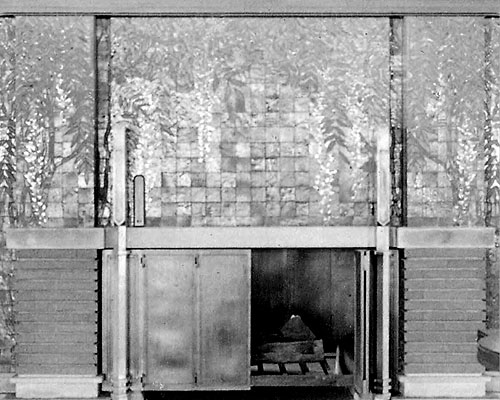 |
|
Figure 7C: Detail of Darwin D. Martin
Residence Fireplace Circa 1908.
(S#0085.41.1018
C) |
| F8 |
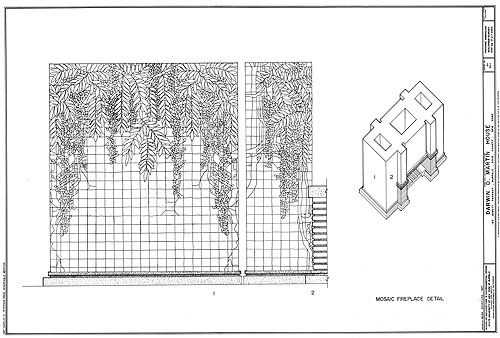 |
|
Figure 8: Darwin D. Martin Residence Mosaic Fireplace Detail 1987 (S.100 -
1904). Historic
American Buildings Survey (HABS) drawing of the Darwin D. Martin
Residence Mosaic Fireplace. Illustrated is the left side (1) and
left front panel (2). Title: Darwin D. Martin House. 125 Jewett
Parkway, Buffalo, Erie County, New York. Drawn by Mark Schryver,
1987. Sheet 26 of 27. (ST#1987.106.1118) |
| |
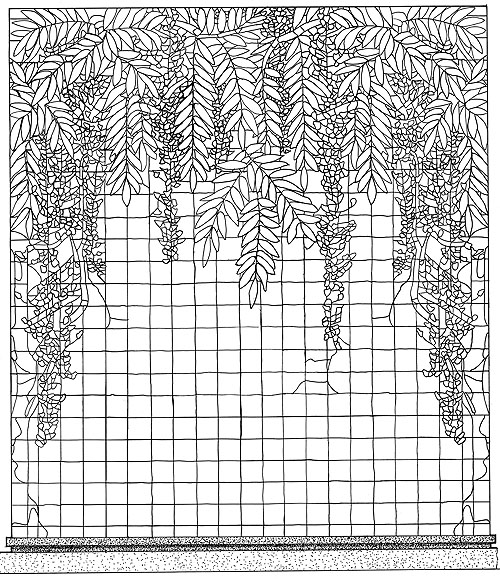 |
|
Figure 8A:
Detail of left side (1). (ST#1987.106.1118A) |
| F9 |
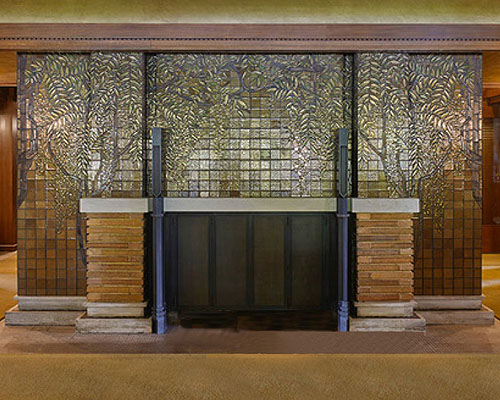 |
|
Figure 9A: Darwin D. Martin Residence Fireplace 2017 (S.100 - 1904).
Frank Lloyd Wright designed the Martin Residence
in 1904. Photographed in 2017 after the extensive restoration of
the Darwin Martin House. (ST#2017.25.1118A) |
| |
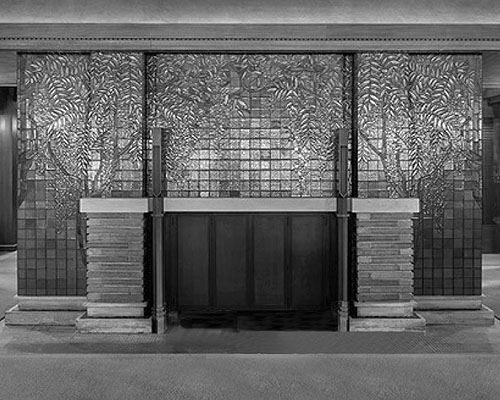 |
|
Figure 9A: Darwin D. Martin Residence Fireplace 2017 (S.100 - 1904).
Frank Lloyd Wright designed the Martin Residence
in 1904. Photographed in 2017 after the extensive restoration of
the Darwin Martin House. (ST#2017.25.1118A) |
|
|
|
|
|
|
|
|
|
|
Leaded Glass |
|
|
|
|
|
In
June 1900, when Plate XXXVII was published in
The Architectural Review,
construction of the Husser Residence was nearly completed.
Photographic records give us scant views of any |
|
leaded
glass windows. Plate XXXVII does give us Wright's intent.
The windows of the main level were drawn in leaded
glass, the second level (top floor) were clear glass. |
|
|
|
|
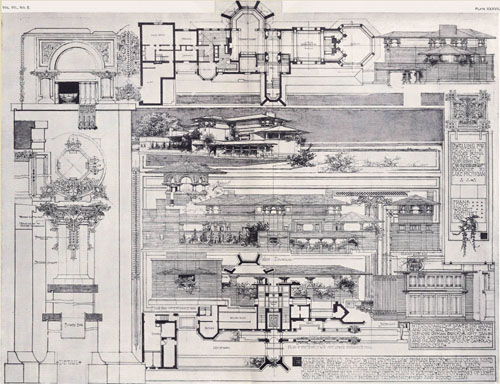 |
| 1) Plate
XXXVII - House for Mrs. Helen W. Husser, Buena Ave., Lake
View, Ill. - Mr. Frank Lloyd Wright, Architect. Published in
the June 1900 issue of
The Architectural Review. |
| |
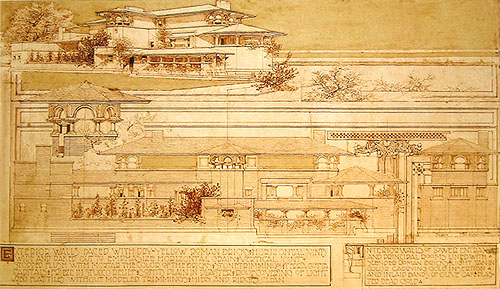 |
| 2) Wright
cropped the original illustration and rearranged the text blocks. |
| |
 |
| 3) From
the illustration above, a look at the West Elevation, a
detail of the leaded glass for the Dining Room Sideboard
(center right), and the East Elevation of the Dining Room
Bay (far right). |
| |
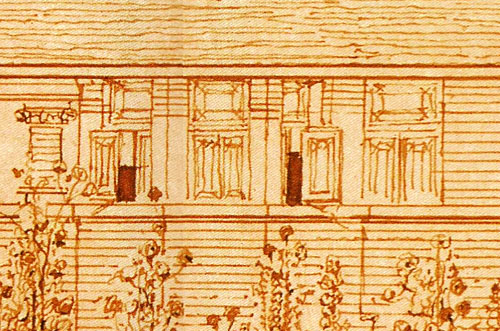 |
| 4) The
three windows on the left for the Breakfast Dining Room, and
the one window on the right for the Kitchen/Pantry were
drawn as leaded glass windows. |
| |
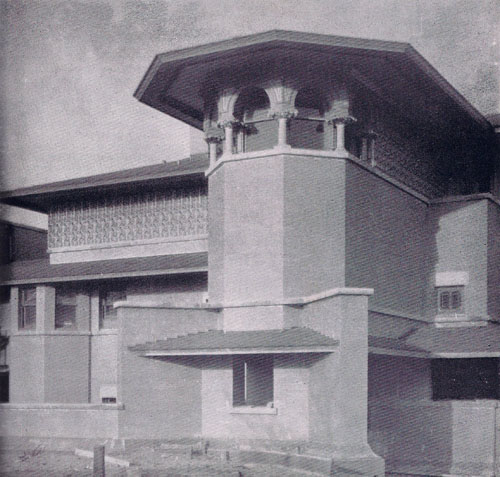 |
| 5) Viewed
from the Southwest. Circa 1900, nearing completion of
construction. One of the few photographs that are clear
enough to see window details seem to indicate the the
Breakfast Dining Room windows (far left), are finished in
clear glass, and lack the detail of leaded glass. But the
small window just to the right of the Stair Bay is clearly
Leaded Glass. The second floor (top level) clearly are plain
glass. Courtesy of the Frank Lloyd Wright
Archives. |
| |
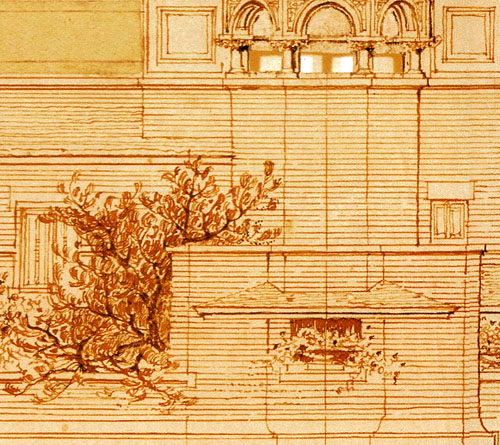 |
| 6) The
window on the left (Study), and
the window on the right (Stair way landing) were
drawn as leaded glass windows. |
| |
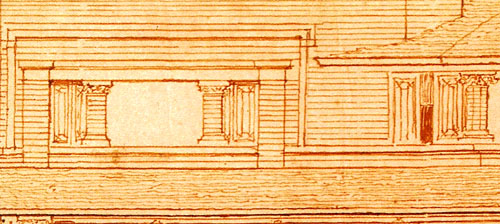 |
| 7) The
windows to the left and right of the Living Room windows
columns are drawn as leaded glass. The Living Room Bay
windows facing South are also drawn as leaded glass windows. |
| |
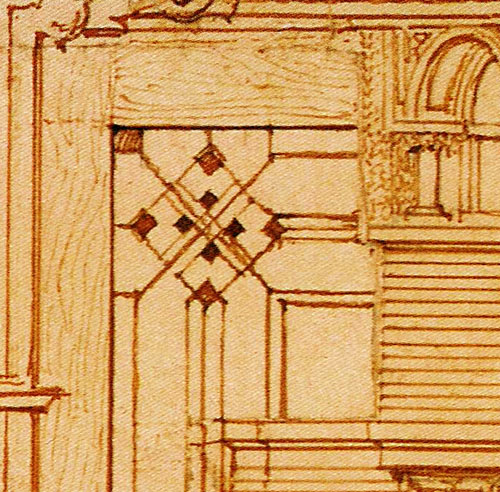 |
|
8) Leaded glass detail. This
illustration shows the detail of the leaded glass pattern of
the doors (left side of upper Sideboard). |
| |
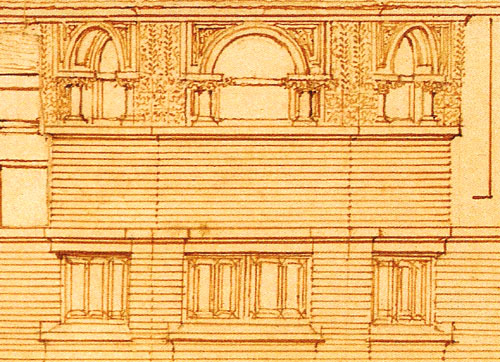 |
| 9) East
Elevation of the Dining Room Bay. Dining Room windows are
illustrated as Leaded Glass windows. The second floor (top
level) are clearly illustrated as plain glass. |
| |
| |
| |
|
|
|
Leaded Glass Windows and Doors |
|
|
|
|
Very few examples exist, and
those that do, give us a scant view of the leaded
glass windows and cabinet doors of the Husser Resident. In
June 1900, when Plate XXXVII was published in
The Architectural Review,
construction of the Husser Residence was nearly completed.
Plate XXXVII give us Wright's design for the upper and lower
cabinet doors of the sideboard.
Purcell's two interior views of also offer
a glimpse of the |
|
Hall cabinet doors and a Dining
Room Bay window.
The question that can not be answered at
this time is whether the drawing Wright published in 1900
were a reality of merely a wishful design. The Purcell
images show a more simplified and scaled back design. With
photographic records of the Hall cabinet doors and Dining
Room Bay window, there is no reason not to conclude the
Purcell photographs are a more accurate record. |
|
|
|
|
|
|
|
Leaded Glass Light Fixtures |
|
|
|
|
|
Because only two interior
photographs exist, few examples of leaded glass light
fixtures. But the one leaded glass example is very exquisite
and complex. The same fixture is used two different ways.
Two are seen on either side of the Dining Room Sideboard.
The leaded glass light fixture are placed atop a pedestal.
The other is on the opposite side of the Dining Room at the
entrance |
|
to the Dining Room Bay. Either side
of the Bay is a single hanging leaded glass light fixture.
The leaded glass shade matched the two shades of the
Sideboard, but is inversed.
The two Purcell photographs are courtesy of
the William Gray Purcell Papers, Northwest Architectural
Archives, University of Minnesota Libraries, Minneapolis,
MN. |
|
|
|
|
| |
|
Interior Photograph #1 (Image 4) |
|
|
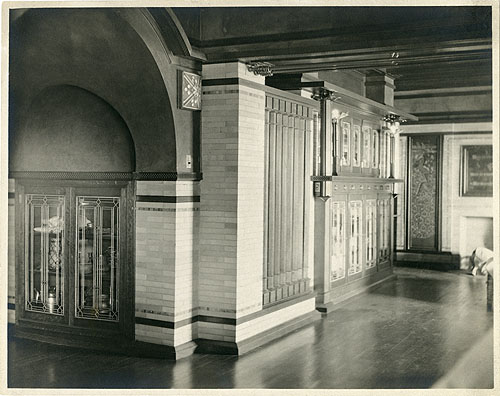 |
| 1) As you
pass through the archway on the left, a stairway leads
down to the
Lower Hall and Entrance. The built-in Sideboard is
just to the right of the spindles. The upper leaded glass
doors are bordered on either side by a leaded glass light
fixture atop a pedestal. Courtesy of the
William Gray
Purcell Papers, Correspondence file: Frank Lloyd Wright,
Northwest Architectural Archives, University of Minnesota
Libraries, Minneapolis, MN. |
|
|
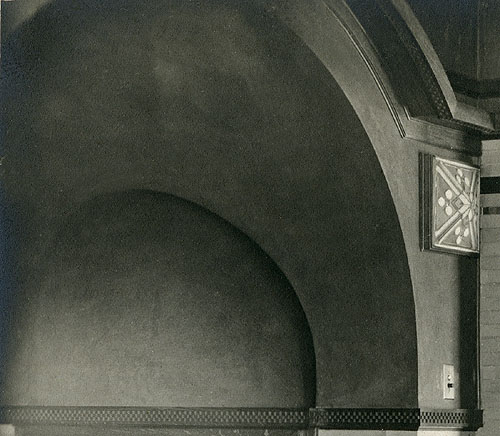 |
| 2)
The decorative square to the right is either a decorative
design or possibly even a wall sconce. Courtesy of the
William Gray
Purcell Papers, Northwest Architectural Archives. |
| |
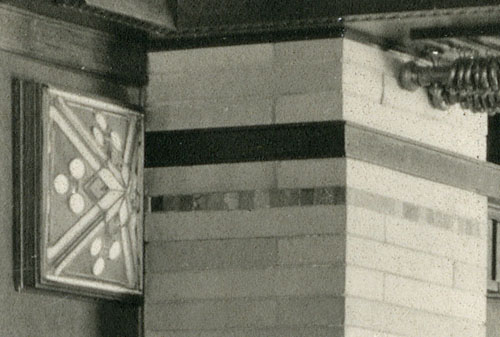 |
| 3)
Detail of the decorative square on the left. It is either a
decorative design or possibly even a wall sconce. Courtesy of the
William Gray
Purcell Papers, Northwest Architectural Archives. |
| |
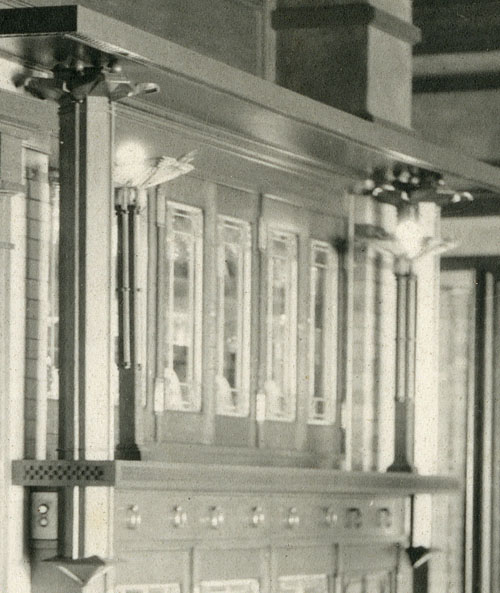 |
| 4)
Detail of the upper portion of the built-in Sideboard. Six
leaded glass doors are bordered on either side by a leaded
glass light fixture atop a pedestal and larger wooden column
with a carved capital. Courtesy of the
William Gray
Purcell Papers, Northwest Architectural Archives. |
| |
|
|
|
Interior Photograph #2 (Image 5) |
|
|
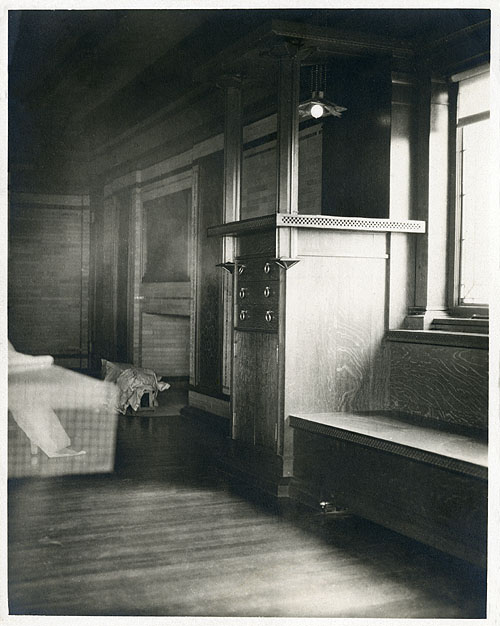 |
| 5) Standing in the Dining Room Bay, the Living Room is to the
far left. A Built-in cabinet sets
off the Dining Room Bay and encompasses a single hanging
leaded glass light fixture. Wright would have envisioned a
planter or sculpture atop the cabinet. The checkerboard
pattern is carved into the cabinet's top. Built-in seating is to the right. Courtesy of the
William Gray
Purcell Papers, Correspondence file: Frank Lloyd Wright,
Northwest Architectural Archives, University of Minnesota
Libraries, Minneapolis, MN. |
| |
| |
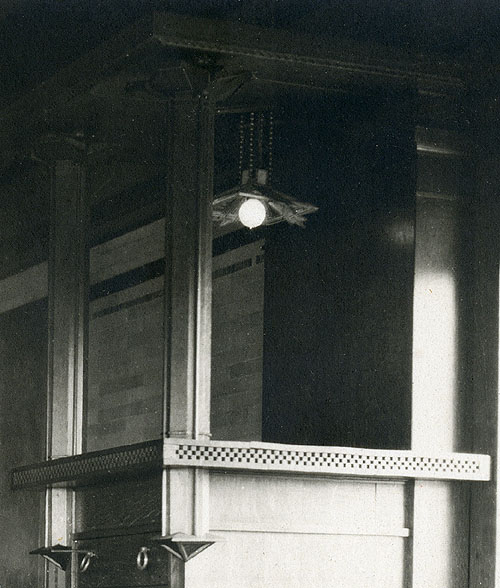 |
| 6) Two Built-in cabinets set
off the Dining Room Bay, one on either side of the entrance
to the Bay. In the center is a single hanging
leaded glass light fixture. It is both very exquisite and
complex. The leaded glass shade matched
the two shades of the Sideboard, but is inversed. Wright would have envisioned a
planter or sculpture atop the cabinet. Courtesy of the
William Gray
Purcell Papers, Northwest Architectural Archives. |
| |
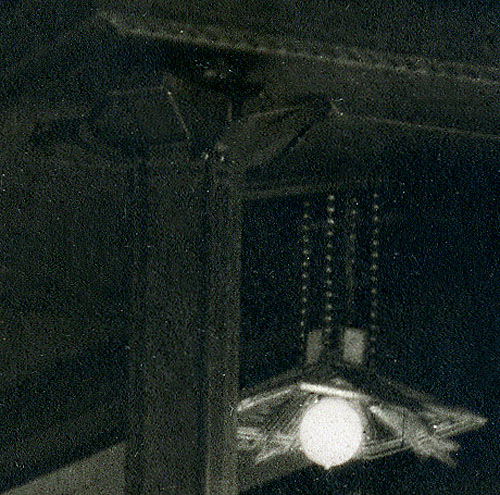 |
| 7)
Detail of the post capital and
leaded glass light fixture. The leaded glass shade matched
the two shades of the Sideboard, but is inversed. It is
both very exquisite and complex.
Courtesy of the
William Gray
Purcell Papers, Northwest Architectural Archives. |
| |
| |
| |
|
|
|
Concrete Vases |
|
|
|
|
|
Large concrete vases were a
signature design element of many of Wright's Prairie homes.
Wright incorporated five large concrete vases visible in
Plate XXXVII of the Husser Residence, published in the
June 1900 issue of
The Architectural Review.
One was |
|
placed in the West opening of
the Porte Cochere. Four were placed in the covered Entrance
Pergola, two on either side of the North end and two on
either side of the South entrance. |
|
|
 |
|
1) Cropped image of Plate
XXXVII - House for Mrs. Helen W. Husser, Buena Ave., Lake
View, Ill. - Mr. Frank Lloyd Wright, Architect. |
|
|
 |
|
2) Wright incorporated five
large concrete vases in the Husser Residence. One was placed
in the West opening of the Porte Cochere (center). Four were
placed in the covered Entrance Pergola, two on either side
of the North end (center) and two on either side of the
South entrance. |
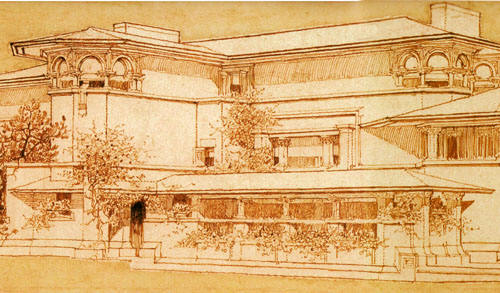 |
|
2a) Detail of the five
large concrete vases in the Husser Residence. One was placed
in the West opening of the Porte Cochere (left center). Four were
placed in the covered Entrance Pergola, two on either side
of the North end (center) and two on either side of the
South entrance (right). |
|
|
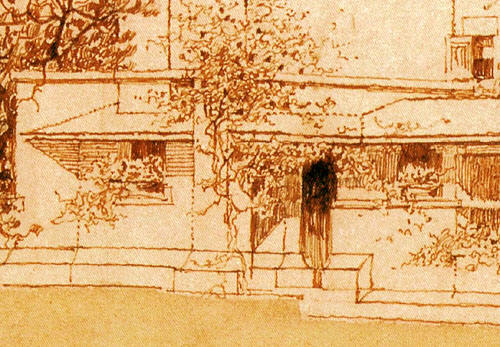 |
|
2b) Detail of the large concrete vases in the Husser Residence. One was placed
in the West opening of the Porte Cochere (left). Two were
placed in the covered Entrance Pergola on either side
of the North end. |
|
|
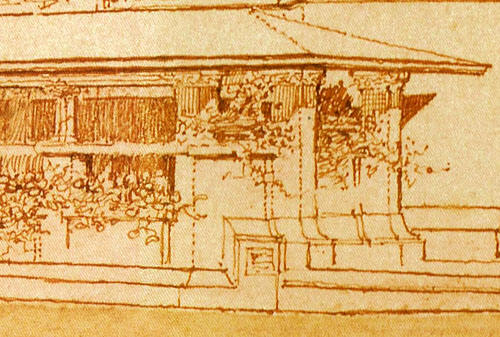 |
|
2c) Detail of the large concrete
vases in the Husser Residence. Two were
placed in the covered Entrance Pergola on either side of the
South entrance. |
|
|
|
|
 |
|
3) Wright incorporated five
large concrete vases in the Husser Residence. One was placed
in the West opening of the Porte Cochere (left). Four were
placed in the covered Entrance Pergola, two on either side
of the North end (left center) and two on either side of the
South entrance. |
|
|
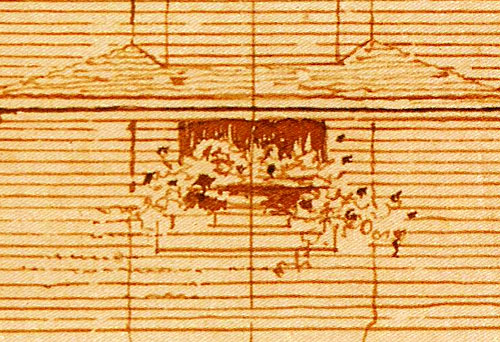 |
|
3a) Detail of the vase placed in
the West opening of the Porte Cochere. |
|
|
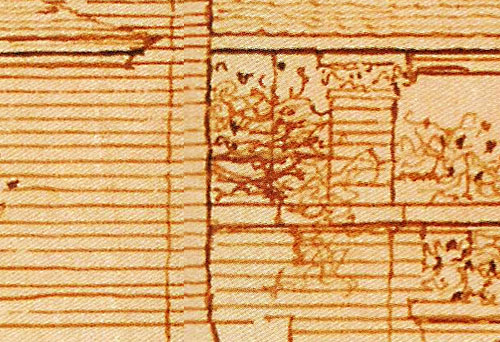 |
|
3b) Detail of the vases placed
in the covered Entrance Pergola on either side of the North
end. |
|
|
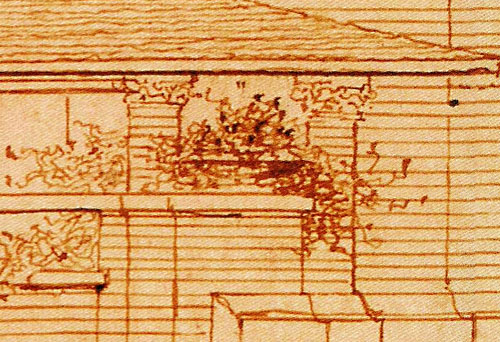 |
|
2c) Detail of the vases placed
in the covered Entrance Pergola on either side of the
South entrance. |
|
|
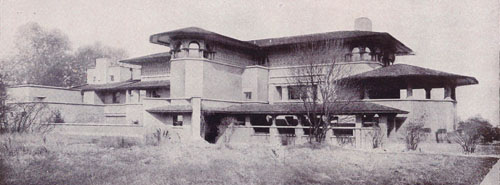 |
|
4)
Viewed from the Southwest, Circa 1900. Five large concrete
vases are visible in the Husser Residence. One was placed in
the West opening of the Porte Cochere. Four were placed in
the covered Entrance Pergola, two on either side of the
North end and two on either side of the South entrance. Published in "Frank
Lloyd Wright,
Chicago". |
| |
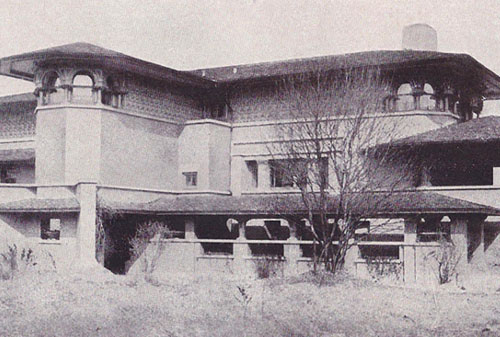 |
| 4a)
Detail of the five large concrete vases visible in the
Husser Residence. One was placed in the West opening of the
Porte Cochere (left). Four were placed in the covered
Entrance Pergola, two on either side of the North end and
two on either side of the South entrance (right). |
| |
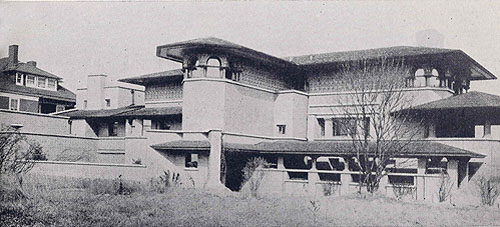 |
| 5) There
is possibly one other vase that is visible on the far left,
on top of the stable. Courtesy of
An Autobiography,
Wright, 1945 (London), Plate 2. |
| |
| |
| |
|
|
Dining Room
Table & Chairs |
|
|
|
|
To date, only one Dining Room
table and eight chairs have survived the destruction of the
Husser residence. According to Irma Strauss, in
the Frank Lloyd Wright Newsletter, First Quarter 1979, the
Husser dining room table and eight chairs were rediscover
after 55 years of use in a private Chicago home. "The mother
of the present owner of the beautiful, almost square, oak
dining room table and eight elegant, high slat-back chairs
recalls purchasing the ensemble in 1923 from Mr. Steinberg,
the proprietor of a second-hand furniture shop
on the near West Side of Chicago. In the shop were a piano
which had been built-in, three similar dining room tables
and 24 matching chairs all of which, Mr. Steinberg reported,
were from a Frank Lloyd Wright designed house on the lake
shore." (p7). They purchased one table and eight chairs.
The table is nearly square, 54 x 60,
and is 28 inches high. |
|
When all three tables were
lined up, the Husser's could entertain a large group in the
Dining Room.
The checkerboard pattern was carved on all
four sides, repeating the design seen throughout the home.
Five inches below the top of the table and five inches above the floor, a small strip of molding
runs horizontally around each table leg as well as each
chair leg. When the chairs are tucked under the table, a
continual horizontal lines runs completely around the table
and chairs.
This Dining Room set was discovered in
1978. In September 1987 the set was auctioned at Christie's
New York. Mr. Monaghan (Dominos Pizza) spent a record $1.6
million. Six years later it was back at
Christie's,
and on June 12, 1993 the same table & eight chairs sold for
$442,500 to Daniel Wolf, a NY photography dealer. |
|
| |
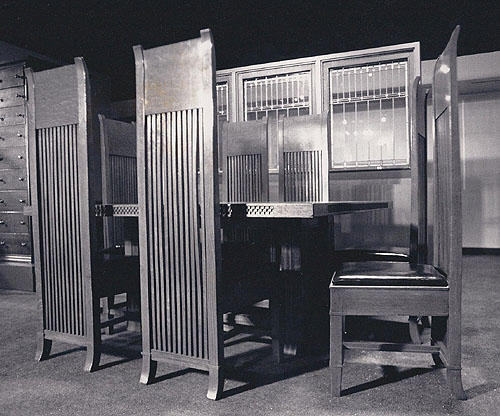 |
| 1)
Domino’s Pizza Collection,
1988. Dining Table
and eight Side Chairs designed by Frank Lloyd Wright in
1899. Clipping on verso: "A Public Display of Passion.
Monaghan’s museum shows off his Wright collection. By Marsha
Miro. Free Press Art Critic. It is truly amazing what Tom
Monaghan’s obsession with the work of the great American
architect Frank Lloyd Wright has brought forth. In three
short years, Monoghan has bought two Wright houses, dozens
of stained glass windows..." Photo Caption: "Tom Monaghan’s
recent acquisition is a $1.6 million Frank Lloyd Wright
dining set." Stamped on verso: "Mar 20 1988", "Photo by
George Waldman". Original 10 x 8 B&W photograph. |
| |
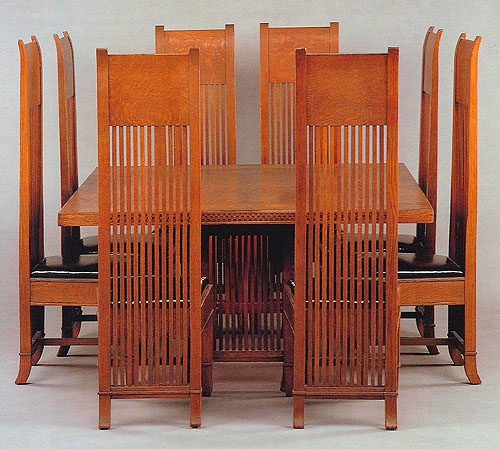 |
| 2) Husser
Dining Room Table and Chairs 1989. Published in "Frank
Lloyd Wright: Preserving an Architectural Heritage, Domino’s
Collect".
By David Hanks 1989. Published in conjunction with an
exhibition organized by the Smithsonian Institution
Traveling Exhibition Service in cooperation with The
National Center for the Study of
Frank Lloyd Wright. |
| |
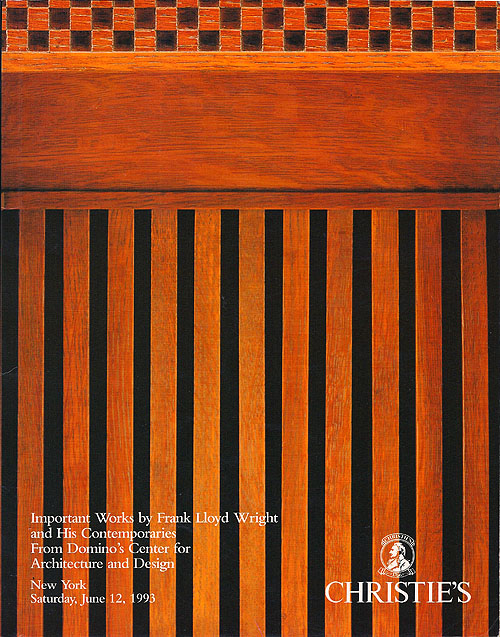 |
| 3) Detail
of the Husser Dining Room table. Cover of the
June
12, 1993 Christie's auction catalog. The checkerboard
pattern was carved on all four sides, repeating the design
seen throughout the home. Five inches below the top of the
table a small strip of molding runs horizontally around each
table leg and borders the top of the square spindles.
Courtesy of Christie's, New York. |
| |
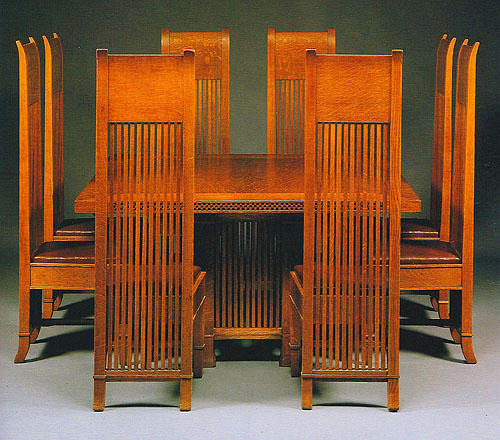 |
| 4) The
Husser Dining Room table and Chairs. The checkerboard
pattern was carved on all four sides, repeating the design
seen throughout the home. About five inches above the floor,
a small strip of molding runs horizontally around each table
leg as well as each chair leg. When the chairs are tucked
under the table, a continual horizontal lines runs
completely around the table and chairs. Courtesy of
Christie's, New York. |
| |
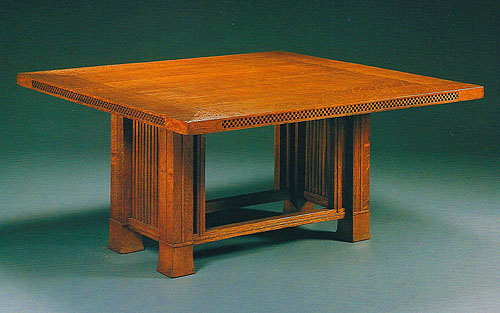 |
| 5) The
Husser Dining Room table. The checkerboard pattern was
carved on all four sides, repeating the design seen
throughout the home. About five inches above the floor, a
small strip of molding runs horizontally around each table
leg. Centered on the face of each leg is a matching strip
that runs vertically and meets the horizontal band that runs
five inches below the top of the table. Courtesy of
Christie's, New York. |
| |
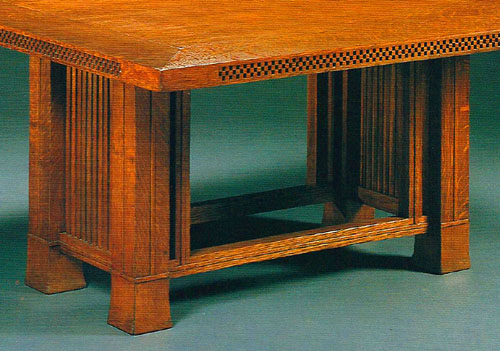 |
| 6) Detail
of the Husser Dining Room table. The checkerboard pattern
was carved on all four sides, repeating the design seen
throughout the home. About five inches above the floor, a
small strip of molding runs horizontally around each table
leg. Centered on the face of each leg is a matching strip
that runs vertically and meets the horizontal band that runs
five inches below the top of the table. Courtesy of
Christie's, New York. |
| |
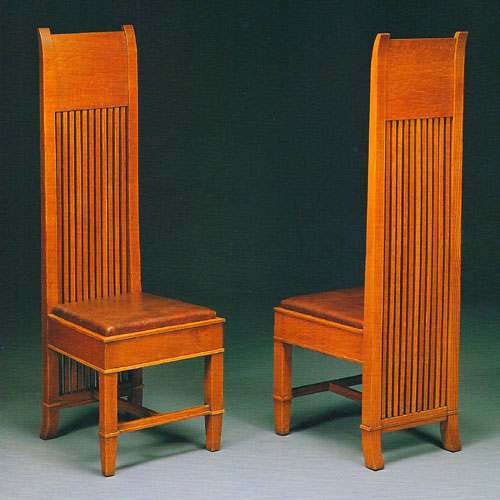 |
| 7) Husser
Dining Room chairs. About five inches above the floor, a
small strip of molding runs horizontally around each chair
leg. Square spindles match the spindles of the Dining Room
table. Courtesy of Christie's, New York. |
| |
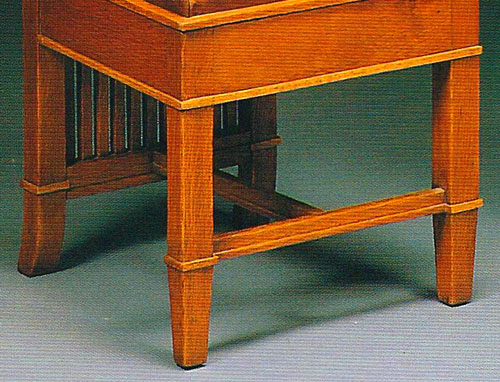 |
| 8) Detail
of the Husser Dining Room chairs. About five inches above
the floor, a small strip of molding runs horizontally around
each chair leg. Square spindles match the spindles of the
Dining Room table. Courtesy of Christie's, New York. |
| |
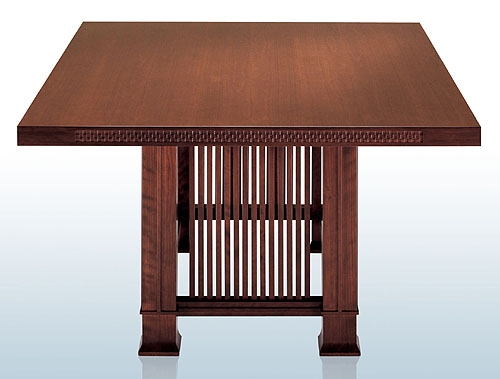 |
| 9) Husser
Dining Room table. Manufactured by
Cassina
USA,
beginning in
1992. The base footprint is 25.98' x 39.76". The table top
is 50" x 60.24" and is 29.13" tall. The checkerboard pattern
is carved on all four sides, repeating the design seen
throughout the home. Five inches above the floor, a small
strip of molding runs horizontally around each table leg and
cross piece. Centered on the face of each leg is a matching
strip that runs vertically to the top of the table. The
table legs and spindles are square. |
| |
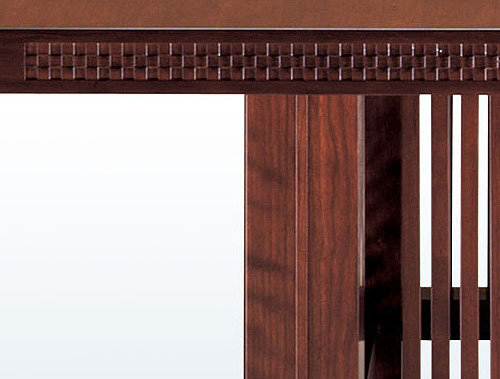 |
| 10) Detail
of the Husser
Dining Room table. The checkerboard pattern is carved on all
four sides, repeating the design seen throughout the home.
Centered on the face of each leg is a matching strip that
runs vertically to the top of the table. The table legs and
spindles are square. |
| |
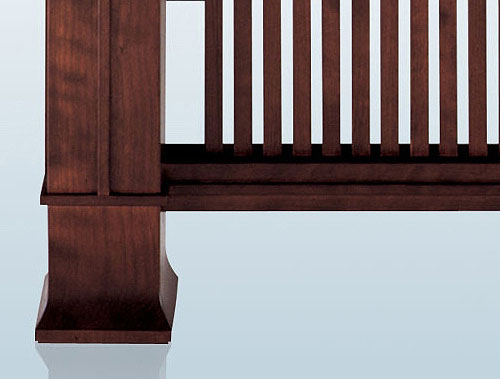 |
| 11) Detail
of the Husser
Dining Room table. Five inches above the floor, a small
strip of molding runs horizontally around each table leg and
cross piece. Centered on the face of each leg is a matching
strip that runs vertically to the top of the table. The
table legs and spindles are square. |
| |
|
|
|
|
|
Back |
|
|
|

CLICK TO ORDER


































